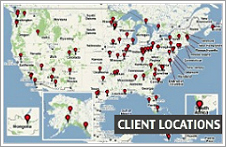You’ve come to the right place for buzzword-free info about work, workplaces, and workplace improvement. These posts are all about improving work processes, strengthening teamwork, sharpening management skills and leadership skills, improving communication, and more. This is info you can use right away, full of practical ideas in straight-talking plain English. Enjoy!
• Have a suggestion or question for a possible future post? Please let us know.
The problem with “my employees”
 You’ve seen how “the devil is in the details.” But did you also know that there’s “trouble in the terminology”?
You’ve seen how “the devil is in the details.” But did you also know that there’s “trouble in the terminology”?
Okay, this new phrase isn’t as catchy as the old “details” phrase. But it makes a crucial point: Some of the words we routinely use end up working against us. Some even do damage.
Take “my” and “employees.” When these two words pair up, they can be real trouble-makers.
You’ve heard them flying off most managerial lips: “I’ll share this information with my employees.” “My employees are on the third floor.” “Chris is one of my employees.”
There’s a reason “my” is a possessive pronoun. It conveys possession. Chris might have an issue with that.
“Employees” also deserves scrutiny. It’s one the words we least hear in everyday conversation, but at its root, it means “making use of.” That’s not terrible, but “associate” has better roots that mean “join with” and “unite.” Other good replacements are “team members” and “colleagues.”
Is all of this much ado about nothing? Perhaps.
But if we’re using certain words just because of verbal muscle memory, is that a good enough reason? If there are better words ready to be used instead, shouldn’t we give them a try? And if our new terminology sends a signal and helps build the kind of workplace culture we’re trying to build, isn’t it worth the change?
So simple: Turning noise into music
 My penchant for playing a vintage Hohner accordion has not endeared me to my neighbors, but it has taught me an unexpected lesson about learning that relates to all of us.
My penchant for playing a vintage Hohner accordion has not endeared me to my neighbors, but it has taught me an unexpected lesson about learning that relates to all of us.
My father used to play the accordion. He played it well, brightening birthdays and livening up more than a few long-ago family gatherings.
When he died in 2004, my sadness somehow steered me to eBay, where I bought an accordion of my own. It was the same model as his, but in mint condition.
The day it arrived, I slipped on the shoulder strap and began to play — if you could call it that. I learned that nothing clears a room more quickly than an accordion in untutored hands.
As the months unfolded, I practiced whenever I had the house to myself. Several times I played outside, on the back porch, but that ended when a backdoor neighbor sent a plaintive wail over the fence: “Shut up!”
My playing improved, but something didn’t seem right. The accordion felt out of position despite the shoulder strap. A separate thumb strap helped stabilize the instrument, but that wasn’t right either, because the constant pull of thumb against strap was beginning to tear the leather.
I kept practicing, but my playing hit a plateau. I tried harder, but got no better. That tear in the thumb strap got worse.
Then something steered me to the Internet. YouTube beckoned, showing me the right way to handle an accordion. It took just five minutes to see the root cause of my problem: I was wearing the strap on my left shoulder when it should have been on the right.
The moment I switched shoulders, my playing began to improve. The thumb strap stopped tearing, and my thumb felt relief too. Best of all, my family began to like me again because I was no longer tormenting them with my noisy determination.
Was it a remedial correction? Absolutely. Should I have figured out the left-to-right switch instead of needing the YouTube assist? Probably. Do I care? Not in the least. I’m just glad to have made the discovery.
The fact is, we all get stuck on plateaus at times. We all face situations where doing things the same way over and over might make things worse.
We’d all benefit from an occasional pause in which we look around, learn from others, pinpoint better practices, and put those practices to work in our own lives.
Even some simple changes can make the difference between noise and music — as my neighbor will tell you.
An in-your-face experience with differences
 It’s not easy being a manager, especially when the road of good intentions is pitted with potential potholes. Here are ten of the biggest along with advice on how to steer clear:
It’s not easy being a manager, especially when the road of good intentions is pitted with potential potholes. Here are ten of the biggest along with advice on how to steer clear:
When I launched my first full-time business in 1991, I brought a lot to the table: two recently written books, solid experience, a Duke University MBA. There was just one big in-my-face problem: I looked about half my age.If you’ve ever watched those TV reruns of The Andy Griffith Show from the 1960s, you’re familiar with little Opie Taylor. That’s pretty much how I looked — but at age 28. The Opie Syndrome had me in its clutches.
In all of my first meetings with would-be clients, I kept getting the same question: “When did you say you graduated?” People stopped just short of asking for my birth certificate.
So I decided to do what Opie never could. I grew a moustache and beard, hoping that some well-tended whiskers would make a difference. And they did! People stopped asking my age, and new sales began to sprout.
Then I paid a sales visit to someone I’ll call Mr. Smith. He owned a company that trained salespeople, so I was literally selling to an expert on selling.
Two minutes into our meeting, the no-nonsense Mr. Smith leaned toward me and locked his gaze onto the lower half of my face. His stare lasted so long that I began thinking he had spotted an errant Rice Krispie or a shelter-seeking bug. Then his trance broke. He eased back, took a deep breath, and declared: “Shave that thing off. You’ll sell more.”
He said it with such conviction that I almost asked for a razor right then and there. But as I drove away, my reaction got more complicated. I could see the humor in our encounter, but I also saw the serious side. People talk a lot about valuing differences, yet here I was being told to shave mine off.
To vent, I wrote a guest column about diversity for the Cincinnati Enquirer. It told my story of growing the beard and getting pressured to stick with the 90 percent of clean-shaven American males. The article ended with a question: What’s it like to have a prominent difference that can’t be shaved off?
Many people answered, calling and writing to tell me about the challenges brought on by their own differences. Most of these testimonials had to do with workplaces where sameness and conformity are quietly expected. All of their experiences were far more serious than mine.
I also heard from critics, lots of them, most of whom seemed to long for a world of their own chosen familiarity. One irate reader clipped the article from the newspaper, covered it with vulgarities, circled my photographed face with a thick marker, and sent it to my house. “You look like Satan,” he wrote.
It’s true that a beard wasn’t my best look. But to compare me to the prince of darkness?! That one hurt.
The range and intensity of the response got me thinking more deeply about the struggle for diversity, respect, and acceptance. I kept coming back to this: If someone’s calling me Satan just because of a beard, what are they doing to people whose differences are more significant?
I kept the beard for a couple more years. Then one Saturday morning, I spotted my electric razor at the back of a bathroom drawer. Ten minutes later the beard was gone — but twenty years later, my beard-based experience with diversity is still very much with me.
A few days into life with a clean-shaven face, I met another business contact. It was our first face-to-face meeting after several phone conversations, and he seemed surprised as we shook hands. “You look awfully young,” he said.
“Funny you should mention that,” I said. “Let me tell you about my beard.”
How a little change can recharge your batteries

Each of us (you, me, everyone) has barely scratched the surface of our potential.
We live with too much of the same routine in the same environment with the same people.
Different doesn’t always mean better, but it can be surprising, and it can teach us how to tap more of our potential.
How’s this for a metaphor: I was using my camera recently when the batteries ran out. It happened at the worst possible moment, and I didn’t have extras. So I improvised in an unusual way, taking the two worn-out AA batteries and switching their positions in the camera. It worked! That instant change-up somehow delivered enough power for five more photographs.
Isn’t that how it often works (on a much bigger scale) in life? You never know when a small change will boost your power and help you do more of what matters most.
The 12 rules of lasting success

These “simple” rules can take a lifetime to master, but they’re well worth the effort. Make them your daily operating procedure and watch the success unfold.
START THE DAY RIGHT.
Figure out what puts you in a positive frame of mind, and make it your morning ritual.
EXPECT GOOD THINGS.
Keep that glass half full by choosing faith and hope over cynicism and skepticism.
TAKE TIME TO BE AWED.
Look through the lens of appreciation and see all that is going right in your workplace.
LIVE A MISSION.
When completing those everyday tasks and projects, see how they contribute to a greater good.
DELIVER EXCELLENCE.
Every job involves service to someone, so serve them well by setting a high standard every day.
MAKE PLENTY OF FRIENDS.
Every workplace is its own community, so reach across the fence, meet your neighbors, and build your network.
SHOW UP ON TIME.
Lower your stress and boost your reputation by being reliably prompt.
BE INCLINED TO SAY YES.
When requests, offers, and invitations come your way, look for every reason to accept.
EXERCISE YOUR STRENGTHS.
You’re good at many things, and you’ll get even better by putting those strengths to work.
SEEK OPPORTUNITY IN ADVERSITY.
When times get tough, search the situation for something to learn or some other way to benefit.
FIND THE RIGHT BALANCE.
Enjoy solitude and social time, work and play, activity and rest, indoors and outdoors…all in the same day…in measures that bring you fulfillment.
LEARN SOMETHING EVERY DAY.
As the sun sets, reflect on your day and identity one discovery you can put to work tomorrow.




